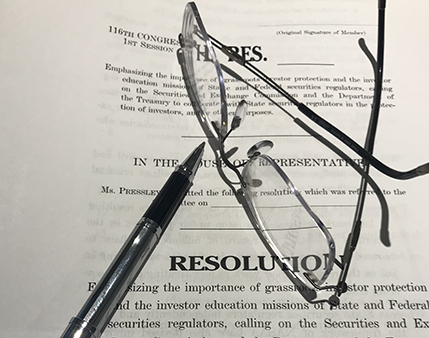Are you an informed investor?
Private Placement Offerings
The COVID-19 pandemic has caused significant disruption and anxiety to individuals and the financial markets. Because fraudsters often try to capitalize on current issues and problems to promote their scams, NASAA is issuing this updated investor alert (published originally in 2013) on exempt securities offerings, also known as “private placements,” in light of the coronavirus pandemic.
What is a Private Placement Offering?
A private placement is a securities offering that is not required by law to be registered with federal or state securities regulators. Private placements allow companies to sell stocks, bonds or other securities to investors without completing the rigorous disclosures necessary in a registered offering.
There are many potential ways in which a securities offering could properly be exempt from registration with the SEC and with state securities regulators. But the rules governing exempt offerings are very complex and navigating them generally requires the advice of legal counsel. Investors should never assume that just because a securities issuer is claiming to offer a security pursuant to a valid exemption from registration that this is actually true.
Investors in private placements should do their own due diligence on the offering, including potentially consulting with their own legal counsel.
Why do Issuers Sell Securities Through Private Placements?
Issuers like to sell securities through private placements because it is generally easier, quicker, and less expensive for the issuer than conducting a registered securities offering. But what is good for an issuer is not necessarily good for investors. Investors in private placements cannot take advantage of the legal protections and disclosure obligations incident to the securities registration process. Investing in securities through a private placement is riskier than investing in the same securities issued through a registered offering.
The most commonly relied upon exemptions from registration are Rules 506(b) and 506(c) of SEC Regulation D. Investors in private placements should be familiar with these rules so they know the ‘rules of the game’ the issuer is supposed to be playing.
The Definition of “Accredited Investor” and Why This Term is Important
As a predicate to understanding Rules 506(b) and 506(c), it is first necessary to understand the legal term “accredited investor.” This term is defined by the SEC and largely governs which individuals can participate in a Regulation D offering.
To qualify as accredited, an individual investor must have a net worth (excluding his or her primary residence) of at least $1 million dollars or an annual income of over $200,000 (or over $300,000 in joint income with a spouse) for the two most recently completed years with a reasonable expectation of achieving the same level of income in the current year. Meeting these financial thresholds thus generally opens the door to an individual’s participation in a Rule 506(b) or Rule 506(c) offering.*
* NOTE: In December 2019, the SEC proposed to amend its definition of “accredited investor” in ways that would expand its scope significantly. The SEC has not yet acted on this proposal, though, and so the future scope of the accredited investor definition is as yet uncertain. Nevertheless, investors should keep in mind that the net worth and income standards discussed above may not in future be the only, nor even the most important, thresholds for qualifying as accredited.
What is the Difference Between a 506(b) Offering and a 506(c) Offering?
Issuers can use Rule 506(b) to sell an unlimited amount of securities to an unlimited number of accredited investors. Up to 35 non-accredited investors to participate in the offering (alongside any accredited investors) provided these non-accredited investors are sophisticated and receive information from the issuer as outlined in Regulation D Rule 502(b). An issuer cannot market the offering through a so-called general solicitation (i.e., through a broad public advertisement via a printed, audiovisual or electronic medium) but rather must rely on informal networks of broker-dealers and professional investors to ‘get the word out’ about the upcoming offering.
Like Rule 506(b), Rule 506(c) permits an issuer to sell an unlimited amount of securities to an unlimited number of accredited investors, however non-accredited investors may not participate in the offering. In addition, the issuer must take reasonable steps to verify that all purchasers are indeed accredited. In exchange for taking on this verification burden, issuers are permitted to make general solicitations about the offering under Rule 506(c).
Private Placements and the Risk of Fraud
Businesses raising capital through private placement offerings often have limited operating histories and frequently have modest revenues compared to larger public companies. They are not required to provide as much information to investors as public companies are required to provide under federal securities laws.
Private offerings made under Rule 506 are not reviewed by regulators and, as a result, there is an increased potential for fraud. The most recent enforcement statistics collected by the North American Securities Administrators Association identified private placements as one of the most frequent sources of enforcement actions by state securities regulators. Private placement offering risks frequently include:
- No Regulatory Review. Because private placements are exempt from registration at the federal and state level, no regulator has reviewed the offering to assess its risks or the background of its promoters and managers. Regulators often only discover fraudulent private placements long after the fraud has occurred – and investors’ money is gone.
- Risk Versus Reward. Private placements frequently tout high returns compared to other available investment options. This is usually necessary, given that private placements are much riskier that registered offerings.
- Securities offered through private placements are generally illiquid, meaning there are limited opportunities for investors to resell the securities. Investors purchasing private placement securities therefore should expect to hold the securities for long periods of time (and may find themselves ‘stuck’ holding securities they no longer want).
- Less Information. Most private placement issuers do not provide investors with the same quality and quantity of information that public companies do. Importantly, the private placement issuer may not be providing audited financial statements, as Regulation D permits issuers to use unaudited financial reports. Investors are usually informed of the risks and merits of the investment and its promoters through a “private placement memorandum” or “PPM” offering circular. Investors should carefully review PPMs to understand the risks and merits of the offering as put forth by the issuer. Investors should also be prepared to do their own due diligence on the disclosures in the PPM and the company itself to verify particularly important information and to assess whether the information in the disclosures overall appears to be reliable.
- General Solicitations. Under Rule 506(c), private securities offerings can be sold pursuant to media campaigns (such as advertisements over the Internet, in radio or television broadcasts, and in print news media). Issuers can also use cold calls, social media posts, and free lunch seminars to advertise their offering. Investors should perform their own due diligence on the disclosures made through a general solicitation as well (and should notify federal or state securities regulators if they believe any of the information being disseminated is materially false or misleading).
- “Bad Actor” Disqualification. Regulation D prohibits issuers from selling securities pursuant to Rule 506(b) or Rule 506(c) if the issuer or certain other “covered persons” (including officers, directors or partners of the issuer) have been subject to a disqualifying disciplinary event, such as a criminal conviction or regulatory action. If you discover that someone associated with a private placement has a personal disciplinary history, be extremely wary of the offering.
How to Protect Yourself When Considering a Private Placement Offering
- Carefully review documents. Do not complete a subscription agreement or accredited investor questionnaire unless you understand and agree with the entire document. Do not allow someone else to check boxes about your wealth and income without reviewing what the document says about your financial situation and verifying its accuracy.
- Don’t fudge your numbers. If you are asked to falsify or overstate your wealth or income to qualify for participation in an investment, walk away – and then notify a securities regulator. Companies relying on Rule 506(c) must verify accredited investor status; if that verification does not happen, investors should hold onto their money.
- Ask good questions. If the promoter cannot satisfactorily answer your questions about a company, then the investment is probably not for you. Promoters should be able to answer questions about the company, its business model, and its executives. Walk away from investment opportunities that you don’t believe you have enough information about.
- Ask for company information. While federal and state securities laws do not mandate as much information disclosure in private offerings as in public offerings, all issuers are still required to provide material information about any securities offering. Take control of your financial future and withhold your investment dollars if you do not get information that might be important to your investment decision.
The Bottom Line
If you are contacted by an investment professional or other individual who recommends that investment in a private placement offering under Rule 506 be sure to first confirm whether they are licensed to give advice or sell investments. You can verify the status of investment professionals and find out whether they have a history of customer harm by contacting your state securities regulator or use tools available for free from the SEC and FINRA.
Updated: May 2020










